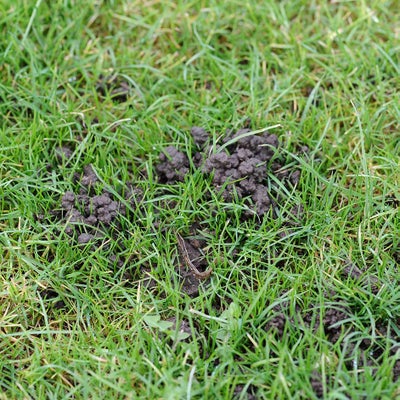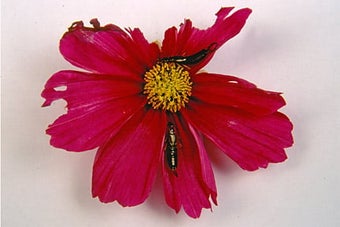
Quick facts
Common name - Worm casts
Areas affected - Lawns and gravel paths
Main cause - Some species of earthworm that excrete worm casts above ground level
Timing - Mainly September to April
What are worm casts?
Worm casts are small heaps of muddy soil ejected from the digestive tract of some species of earthworm, mainly Aporrectodea and Lumbricus species. These earthworms live in permanent vertical burrows drawing leaves and other plant debris down; worms exhibiting this behaviour are classified as anecic. In most cases worm casts can be tolerated and brushed off when dry; a minor inconvenience compared to the benefits of soil aeration and nutrient recycling. On some fine lawns, such as that which is low cut for sport, and gravel paths worm casts may be considered undesirable by some gardeners.
Symptoms
Earthworms are soil-dwelling animals that have elongate cylindrical segmented bodies. Adult earthworms have a distinctive thickened band, known as the clitellum, about one third of the way down the body from the head end, this is part of the reproductive system of the worm.
Earthworm activities are beneficial in gardens, for both soil structure and in nutrient recycling. Earthworms feed on dead plant material and in doing so ingest a certain amount of soil. As a consequence, an earthworm's excrement has a muddy consistency and appearance. Most earthworm species void waste material underground but a few species deposit casts on the surface. In most cases worm casts can be tolerated and brushed off when dry. Some gardeners collect these casts and use them as a potting medium. Worm casts may however be undesirable by some gardeners trying to achieve fine low cut lawns and in pathways, particularly if the casts get squashed and spread over the surface by trampling feet or lawnmowers. This can create places where mosses and lawn weeds can establish.
Worm casts can be distinguished from soil brought up to the surface by other lawn animals, such as ants, mining bees and moles, by the fine muddy nature of the excreted soil. Freshly deposited worm casts often have a coiled appearance.
Find out more about earthworms and earthworm research at Earthworm Watch and the Earthworm Society of Britain (link to external websites).
Management
The action of worms in the garden is beneficial, worms are an important part of a healthy garden ecosystem and so casting worms should be tolerated wherever possible.
Raking can break up and disperse worm casts. On lawns using a wire rake with the teeth facing upwards, and moving it from side to side over the lawn surface, can help reduce their noticeability. On paths removal with a trowel can be a simple solution. This is only possible when the casts are dry. The deposition of worm casts tends to peak in autumn and early spring, and in mild winters can continue throughout the winter. There are often very few days during autumn-spring when worm casts are dry enough to be dispersed. It is best to keep off lawns as much as possible during that period.
Treatments can be applied. Earthworms are much less abundant in acidic soils, so in theory reducing the soil (acidification) should help to reduce a worm cast problem. Reducing food sources such as clippings and fallen leaves and top dressing with sand have also been suggested as methods of reducing earthworm numbers. These methods can be labour intensive and produce mixed results. Further information can be found from the Sports Turf Research Institute (external website).
Products containing sulphur, such as Cast Clear® are offered to the home gardener which may reduce pH. These products do not kill worms but are sold as deterrents. They often need repeated application to remain effective. Other products are also available to lower soil pH. If the soil is alkaline, i.e. above pH7, it would be difficult to make the soil sufficiently acidic to deter earthworms. If the soil is already acidic, i.e. below pH7, there is a possibility that repeated applications of sulphur might make the soil too acidic and adversely affect grass growth. It is easy to test soil to check the pH.
Biology
Earthworms are hermaphrodite animals that pair up to exchange semen. Eggs are deposited in the soil in lemon-shaped egg sacks. These eggs hatch into small worms similar, in appearance to the adults, they gradually increase in size as they develop. Different species of earthworm occupy different habitats. Some live in heaps or other accumulations of rotting organic matter, while others live in the soil. Some species live near the soil surface while others occur deeper underground. In most situations the activities of earthworms improve soil structure.
















